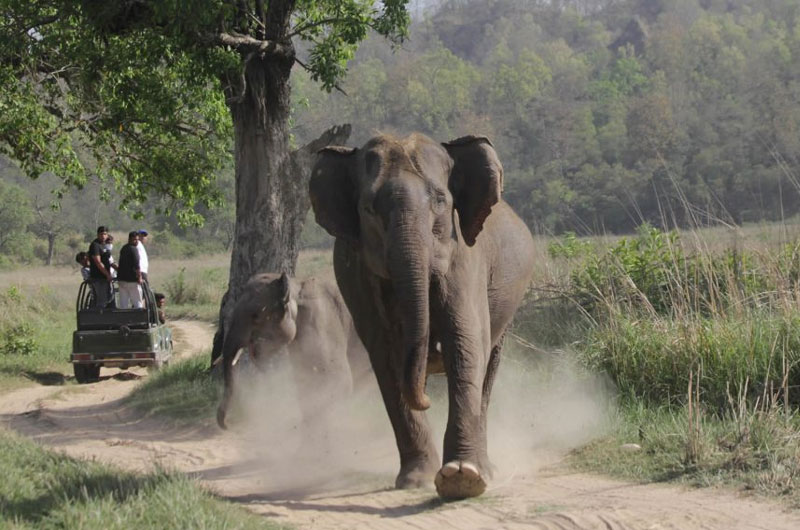
Rajaji National Park: Where Wilderness Thrives
Rajaji National Park, located in the state of Uttarakhand, India, is a sprawling wildlife sanctuary known for its rich biodiversity and scenic landscapes. Established in 1983, the park covers an area of approximately 820 square kilometers and is named after C. Rajagopalachari, a prominent Indian statesman and freedom fighter. Rajaji National Park is celebrated for its diverse flora and fauna, including iconic species like the Bengal tiger, Asian elephant, and several species of deer. This guide provides a detailed overview of Rajaji National Park, highlighting its specialties, locality, best time to visit, and nearby amenities.
Overview of Rajaji National Park
Location and Geography
- Locality: Uttarakhand, India
- Geographical Features:
- Spread across the Shivalik ranges of the Himalayas
- Includes diverse ecosystems such as dense forests, grasslands, and riverine habitats
- Located near the towns of Haridwar, Rishikesh, and Dehradun
Specialty
- Biodiversity Hotspot:
- Home to over 500 species of birds and various mammals, reptiles, and amphibians
- Important corridor for wildlife movement between the Himalayan foothills and the Indo-Gangetic plains
- Habitat for endangered species like the Bengal tiger and Asian elephant
Best Time to Visit
- Optimal Seasons: November to March
- Weather Conditions:
- Winter (November to February): Cool and pleasant, ideal for wildlife sightings
- Spring (March to April): Blooming flora, good birdwatching opportunities
- Summer (May to June): Hot days, chances to spot wildlife near water sources
- Monsoon (July to October): Park remains closed due to heavy rains and flooding
Wildlife and Flora
Fauna
- Mammals:
- Bengal tiger, Asian elephant, leopard, sloth bear, and several deer species
- Langurs, macaques, and smaller mammals like pangolins and civets
Avifauna
- Birds:
- Over 500 bird species including hornbills, woodpeckers, kingfishers, and migratory birds
- Rich diversity due to varied habitats ranging from forests to riverbanks
Reptiles and Amphibians
- Reptiles:
- Gharials, pythons, cobras, and numerous species of lizards and turtles.
- Amphibians:
- Various frogs and toads reside in the park’s moist environment
Flora
- Vegetation Types:
- Sal forests, mixed deciduous forests, and riverine vegetation
- Rich plant diversity supporting the park’s wildlife populations
Zones and Activities
Main Zones
- Chilla Zone:
- Core area for wildlife safaris and nature trails
- Offers jeep safaris and elephant safaris
Activities
- Wildlife Safaris:
- Jeep safaris through designated trails
- Elephant safaris for up-close encounters with wildlife
- Birdwatching:
- Guided tours to birdwatching hotspots
- Opportunities for spotting endemic and migratory birds
- Nature Walks:
- Interpretive walks with knowledgeable guides
- Explore diverse habitats and learn about local flora and fauna
Nearby Restaurants and Hotels
Restaurants
- Chandni Chowk Restaurant:
- Offers North Indian cuisine and local delicacies
- Located near the park entrance in Haridwar
Hotels and Lodges
- Aalia Resort:
- Luxury resort overlooking the Ganges River
- Provides wildlife safari packages and outdoor activities
- Ganga Kinare:
- Riverside hotel in Rishikesh
- Offers comfortable accommodations and nature-inspired experiences
- Regenta Orko’s Haridwar:
- Modern hotel with convenient access to Rajaji National Park
- Provides guided tours and safari arrangements
Conclusion
Rajaji National Park offers a captivating wilderness experience amidst the scenic Shivalik ranges. As a biodiversity hotspot, it serves as a vital habitat for numerous species and contributes significantly to wildlife conservation efforts in India. Whether you are a wildlife enthusiast, a birdwatcher, or a nature lover, Rajaji National Park promises an enriching journey through its diverse landscapes and abundant wildlife. Plan your visit during the recommended seasons to maximize wildlife sightings and explore the park’s natural beauty and ecological importance.
